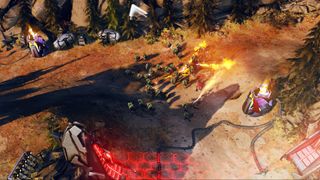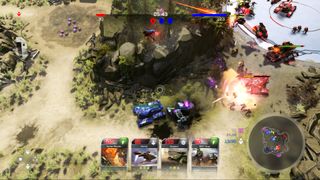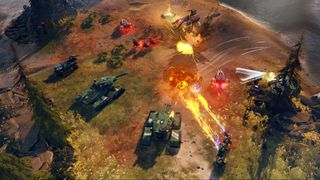'Halo Wars 2' Early Preview: Something For Everyone

Real-time strategy (RTS) games aren’t my cup of tea. I prefer the slow and thoughtful process that goes with turn-based strategy games. However, I might be more inclined to play more RTS games based on my early hands-on time with Halo Wars 2. Last week, I was invited to 343 Industries in Redmond, Washington to try out the game before it launches on February 21, 2017.
Wake Up And Get Back Into The Action
Just like the original Halo Wars, Halo Wars 2 focuses on the United Nations Space Command (UNSC) ship Spirit of Fire and her crew, all of whom just woke up from a long cryosleep. Twenty-eight years after the first game and right after the events of Halo 5: Guardians, the crew discovered the Ark, the Forerunner base that manufactured the Halo rings. However, the surrounding area is plagued with a new enemy called the Banished, a faction that was created after the Covenant empire collapsed. The Banished are led by Atriox, a massive Brute who is both smart and intimidating. With the forces of the Spirit of Fire under your command, you’ll have to land on the Ark and fight the Banished to stop their evil plan.
In terms of the campaign, Halo Wars veterans will be in familiar territory; most of the same mechanics are still in place. General RTS fans won’t have any issues acclimating to the game, either. With your armies, you can assign units to specific groups for easy management. Some special units, such as the Spartan Jerome, have unique abilities. Specifically, Jerome can call down a healing drone that restores some health to all friendly units within a small radius. On top of commanding your troops, you’ll also have to manage supply and power resources to build additional troops or provide boosts to existing units. You can also build other structures in one of the base’s open slots.
Obviously, you’ll have a main objective in each level, but there are also some bonus objectives available. You might have to destroy a small number of enemy structures with a specific unit, for example, or use a special unit’s unique abilities ten times in a single level.
Considering my inexperience with RTS titles, it was quite a challenge to meet the bonus objectives. Most of the time, I just wanted my troops to survive until the end. In all the chaos that ensued during the campaign demo, it wasn’t clear to me what I received when I finished a bonus objective. If anything, it appears to serve as an extra challenge for subsequent playthroughs.
Despite my inexperience with the genre, I found the game easy to play. After all, it was just a series of mouse clicks to move soldiers, add buildings, or make more units. The real challenge was when I had to control units in battle. Some were better suited against vehicles, but other soldiers were more effective from a distance. My army could disappear in a matter of seconds if I had the wrong matchup or moved troops too close to a enemy’s range of fire.
It took me a few minutes to adjust to the combat, but I eventually reached the leader of the local Banished troops, Decimus, one of Atriox’s lieutenants. Just like my special units, Decimus had a unique ability: He can call down a powerful orbital strike that kills enemies in its radius. For a few minutes, I moved troops toward Decimus when he was vulnerable and tried to get them out of harm’s way when he activated his power. Most of my troops were decimated by the enemy, but I eventually wore him down and won the fight to finish the level.
Stay on the Cutting Edge
Join the experts who read Tom's Hardware for the inside track on enthusiast PC tech news — and have for over 25 years. We'll send breaking news and in-depth reviews of CPUs, GPUs, AI, maker hardware and more straight to your inbox.
Shorter, Better, Faster, Blitz-er
If you don’t want to play single-player, there are a few competitive multiplayer modes available. However, that wasn't the main attraction during my visit at 343 Industries. Instead, the development team introduced a new game mode called Blitz, which is a fast-paced multiplayer or single-player game that combines basic troop management with cards. It’s a strange combination, to be sure, but after a few rounds I actually found it to be my favorite part of the entire game.
You can play Blitz by yourself in the Firefight mode or compete with other human opponents in Player versus Player (PvP) gameplay. Instead of constructing a base, building units, and gathering resources, Blitz simplifies gameplay to just summoning and managing troops with a deck of cards.
Each deck has 12 cards that correspond to a unit or ability. Playing a card requires a specific amount of energy points. A basic ground unit can cost 30 points; more powerful, specialized units such as the Scarab or a devastating barrage of missiles cost between 200-300 points. Energy pods will drop in random locations on the map as the round continues. If you want more energy points, you’ll need to destroy the pods.
However, your opponent can send their own units to steal the points. Winning requires you to take over the three zoned areas in the map, and the more zones you control, the more points you accrue. In PvP, the first side to reach 200 points wins. In Firefight, which is similar to the Horde mode in the Gears of War games, you have to survive and claim each zone for as long as possible to raise your high score.
For the demo, I gained additional card packs with every victory, but the final version of the game will award packs for completing daily challenges. If you don’t like the challenges, you can play the campaign to earn a card pack that has some units or abilities featured in a specific level. And for anyone who doesn’t like either option, you can always buy card packs with real-world money.
Each pack contains a combination of units and abilities, and some cards are restricted to a specific faction leader. At the event, I had to choose between the Banished and UNSC-themed decks that had Atriox and Captain James Cutter, respectively, as its leaders. With each leader, I was allotted three deck slots so I could make different sets for varying strategies. At launch, you can choose cards from six different leaders. After launch, the developers will release more leaders and cards in the form of downloadable content (DLC).

It doesn’t take long to appreciate Blitz, because it’s filled with non-stop action. You’re always directing troops to take a zone or sending them to an opposing zone to fight the enemy. While your armies move, you’re spending energy to summon reinforcements or powers to turn the tide in battle. There’s always something to do in Blitz, and you have to act fast if you want to win.
According to Blitz project lead Oli Smith, the combination of RTS gameplay with cards was the best way for players to learn about the mode’s mechanics in a short amount of time.
“Cards are fantastic for getting new players to understand complicated mechanics. Everybody understands that language of a hand of cards, playing a card and having a deck of cards. These are things that allow people to make a mental picture of stuff that is actually fairly complicated. By using that as an entry point, [where the player says] 'I don't know too much about strategy, but I do know how card games work.' Having this call and response [with cards] allowed us to have this more adaptive gameplay.”
As fun as it was to take on waves of AI enemies in Firefight, the most exciting moments came during PvP. In each round, I was paired with another player, and we worked together against two other players (Blitz PvP supports up to two teams of three). Blitz required more strategy in PvP, as I shared energy points with my fellow partner. I didn’t want to take all the points for myself, but at the same time, I needed a few units to stay alive in order to control one of the zones for the team.
Communication is important in these situations so you can form some sort of attack plan. Fortunately, my partner and I were seated next to each other. Together we had a “divide and conquer” plan. His large army could hold two zones, while my smaller, faster troops could run around the map and gather energy points when they became available.
Near the end of the round, we managed to win because we gathered so much energy. This allowed me to summon my most powerful card: a massive Scarab that destroyed everything in its path. Combined with another card that provided a barrage of missiles, we kicked the enemy out of their zone and reached the 200-point limit to win the round.
A Tale Of Two Studios
For the development of Halo Wars 2, 343 Industries enlisted the help of Creative Assembly, the studio behind the popular Total War strategy franchise. According to Dan Ayoub, 343 Industries’ studio head for its Strategy Games Development division, the partnership was nothing short of perfect.
“Whenever we look at a partner, there’s a base competency that you’re looking for, that talent or expertise in the field. There’s also has to be compatibility and a love of the franchise, and if it’s not there, that technical excellence is not enough, because you won’t see it in the quality of the work,” he said. “What we realized very quickly when we started our conversations with CA [Creative Assembly] is, first of all, there’s great chemistry, but there’s [also] a lot of shared love for Halo and a lot of shared purpose for what we wanted to do.”

For Creative Assembly executive producer David Nicholson, Halo Wars 2 wasn’t just another RTS title. It would be a game that would make a significant mark in the genre.
“If 343 [is] making a game, it’s going to have a fantastic story. If CA [is] making a game, it’s going to be an amazing RTS. When the two come together, you’re guaranteed that [the game] is going to be both of those, but it’s also going to innovate.”
The game will also be the first full Halotitle on PC, which adds some pressure to development. For Ayoub, it’s all about keeping a balance between the console and PC versions.
“[It] gives us a really exciting opportunity to fully understand what makes an RTS fun and what controls you need,” he said. “So we’ve tried to take the complexities and dexterity, the fine detail that you have on the PC and bring that over to [the] console, but also take some of the constraints of the console controller, meaning that you have to refine it down to the core controls and mechanics that you need and apply those to the PC so that it doesn’t get diluted.”
Something For Everyone
After playing the game for about five hours, I left the studio excited for the final version of the game. Depending on your interest in the Halo franchise or RTS games in general, there’s a game mode for every type of player. The main campaign is for those who want to learn more about the franchise universe; the multiplayer is for those who want to sharpen their skills as an armchair general. For me, and for many others inexperienced with the RTS genre, it’s Blitz all the way. It’s an enjoyable and fast way to get into the game without knowledge of RTS mechanics.
The fact that it’s coming to PC as well is a no-brainer. Strategy games thrive on PC, and Halo Wars 2 is sure to attract fans of the genre who are looking for a new challenge.
For most people, the Halo franchise is just made of first-person shooter titles. The first Halo Wars game broke that mold, and it garnered a loyal fan base. Halo Wars 2, then, seems to live up to fans’ expectations, but it also manages to find a way to attract new players thanks to Blitz mode and its release on PC.
-
jkhoward This looks like is it could be a lot of fun. Any idea if they have a custom map editor similar to Blizzard RTS games?Reply -
RomeoReject Excited for this, but hope it eventually ends up on something other than Windows 10...Reply -
jasonelmore go windows 10 or go bust and keep playing the same stale lineup. i'm looking at you windows 7 holdouts! dont you want DX12?Reply
Most Popular






